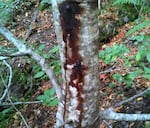
The Bloedel Reserve on Puget Sound's Bainbridge Island.
Eilís O'Neill, KUOW / EarthFix
It’s a sunny spring morning at the Bloedel Reserve, a public garden on Puget Sound's Bainbridge Island. Roads lead to paths lined with blossoming bushes and trees.
Darren Strenge, the reserve's plant health manager, is showing me the rhododendron glen. That's where a gardener first spotted a problem back in 2015: a plant that wasn't healthy.
"Some leaves were dying completely. And a couple of significant branches were dying off," he recalled.
Strenge took a sample and sent it into a lab. The answer came back: the plant had the pathogen that causes sudden oak death.
The disease has decimated forests in California and infected forests in southwestern Oregon. And now it’s made a return to Western Washington, where rhododendrons, Douglas firs, and western larches are most susceptible. It has the potential for such disastrous effects that agencies, scientists, and citizens are working together to try to keep it under control.
From the vault: NPR on the trail of sudden Oak Death in Portland in 2003
Sudden oak death is a water-borne mold called phytophthora ramorum — taken from the ancient Greek expression, plant destroyer.
One species of phytophthora caused the potato famine in Ireland. In California and Southwest Oregon, sudden oak death has felled millions of tanoaks.

A tanoak tree in Northern California's Humboldt County, killed by sudden oak death. Oaks have no natural resistance to the disease, and suffer 100 percent mortality when infected.
Courtesy University of California Extension
Western Washington and much of western Oregon don’t have tanoaks, but they do have the cool, wet climate the water mold loves. They also have hundreds of plants that are susceptible to infection. That’s why the U.S. Department of Agriculture descended on the Bloedel Reserve just weeks after the mold was found. They found it at fourteen sites throughout the garden, says Andy Navage, the reserve's director of grounds and horticulture.
"Right from the get-go it seemed fairly hopeless. You have a mandatory destruction zone of two meters, so the potential was that everything around you that you see would have to be destroyed," he said. "It instills fear and anxiety. It would be hundreds of thousands of dollars to mitigate this garden space."
Navage and his team set to work pulling plants out of the fourteen sites, steaming the soil to kill the mold, and rebuilding paths to change the way water moves around the garden.
The mold was detected early here, because gardeners are constantly checking on the plants, but, in the wild, it could spread fast. So far, it’s been detected in forty-five nurseries whose stock includes infected plants brought in from California, Oregon, or British Columbia. And it’s been found in streams and rivers up and down the Interstate 5 corridor and in the Dungeness River out on the Olympic Peninsula.
In plants other than tanoak, the water mold doesn’t kill the plant but rather some of its leaves and shoots and sometimes its branches. But that’s still a huge problem, says Gary Chastagner, at Washington State University.

Gary Chastagner, a plant pathologist at Washington State University's Research and Extension Center in Puyallup.
Eilís O'Neill, KUOW / EarthFix
"If it's detected in a forest or a landscape situation where it's spreading, those areas would go under a quarantine," he said, "which would have a tremendous economic impact to not only the forest community but also the nursery industry, the timber industry, the Christmas tree industry."
In California, it has cost an estimated $150 million dollars in lost property values and efforts to control the disease, according to a study that didn't include the cost of increased fire risk or the loss of ecosystem services.
That's why the Washington Department of Natural Resources is trying to track its spread across the state.
Early detection is the key to keeping the pathogen from doing the kind of damage to Washington's forests that it's done to forests further south. And it's what eventually saved the Bloedel Reserve, where Navage is pretty sure his team has won the battle. No one here has detected the mold for a year. But, across the western states, people are still on high alert.
